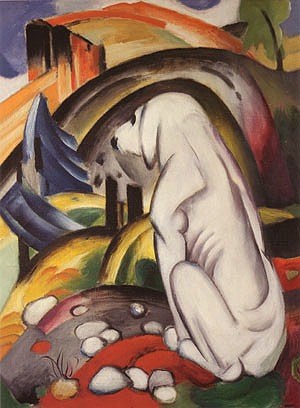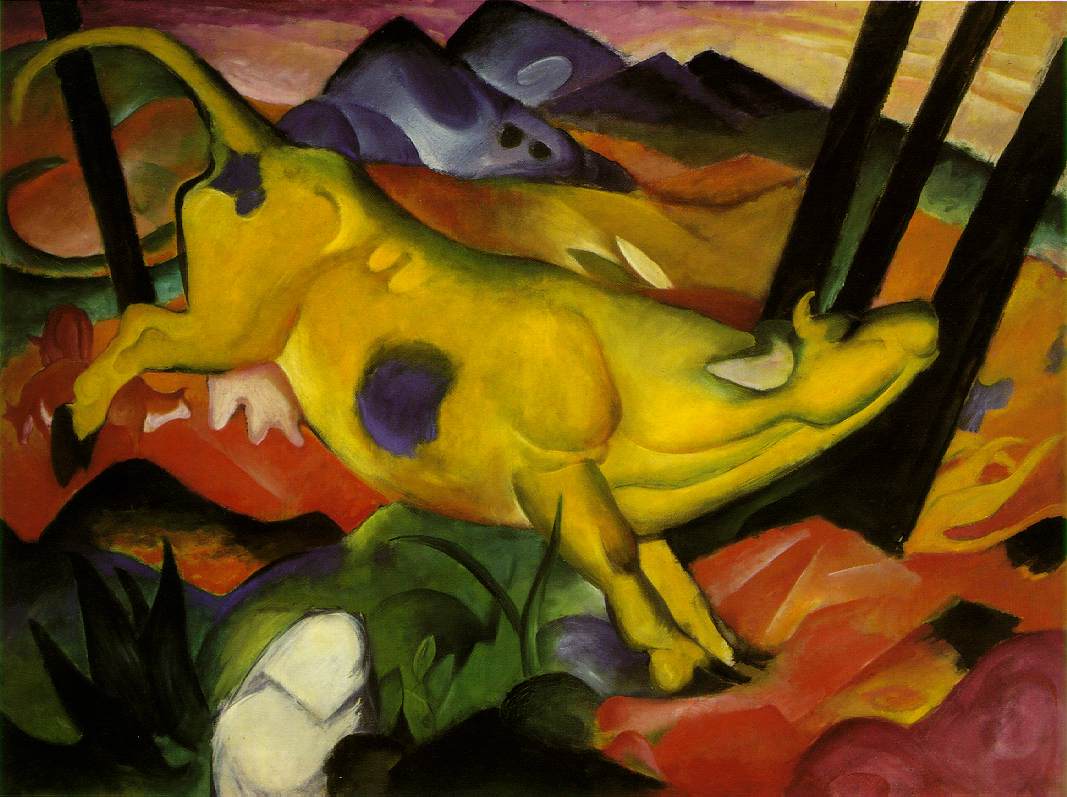
Hund vor der Welt, Franz Marc (1912). Oil on canvas, 118 by 83 centimetres, private collection, Switzerland
I write about this painting a lot – in fact I once, for quite a long time, devoted my academic research solely to this painting – but I realised I don’t often say anything about it in this space. So here is a little excerpt not from my current chapters but from a side project.
§ § §
Franz Marc made an innovative painting – a metaphysical genre portrait of his dog Russi – called Hund vor der Welt in the spring of 1912. The large vertical canvas shows the white hound seated on a hillside, facing the sun and the landscape at an angle across an indeterminate space. We have an account of what Marc had in mind in making this image in particular and Marc’s other thoughts about painting his frequent model.[1] There is also a substantial amount of documentation about Russi, the dog, who, as the artist’s constant companion, was a character who populated the art, photographs, and writing of other people. We even know where Russi was born, how he came as a puppy to live with Marc, and when he died.[2] So despite its slightly whimsical affect, Hund vor der Welt is an image of a real dog about whom much historical information is available. Marc made many paintings in which Russi also appears as a peripheral regular “character;” he leads the way in Im Regen (1912) and leaps after Die gelbe Kuh (1911).
August Macke, who came into frequent contact with Russi and made his own drawings of the dog, prevailed upon Marc to change the name of the painting from the one Marc originally had in mind, So wird mein Hund die Welt sieht.3 We know from Marc that he wanted to show Russi in thought, so the dog’s seated posture suggests that this is what is happening in the stillness. The strange view of the landscape Russi “sees” is nonetheless completely identifiable as a typical one from around Sindelsdorf where Marc lived. By placing buildings in the recognizable, managed farmlands of Bavaria, Marc suggests that people and animals are part of the same ecology, which, for dogs as the primary animal of domestication, is certainly true.
Russi did not have the life of a working dog, instead, with Marc, dividing his time between Munich, Berlin, and the small towns of Sindelsdorf and Ried. Russi lost part of his tail in 1911, an adjustment to his appearance that is reflected in his 1912 portrait. This shows that Marc had a commitment to showing morphologically accurate details even about the animals he painted, even as the paintings themselves broke with academic naturalism.

Die gelbe Kuh,
Franz Marc, 1911
189.2 × 140.52 cm
Oil on canvas
Solomon R. Guggenheim Museum, New York. That is Russi Marc in the lower left corner.
[1] Franz Marc, Briefe, Schriften und Aufzeichnungen, (Leipzig: Kiepenheuer, 1989), 11. Observing Russi at this moment, Marc wonders: “Ich möchte mal wissen, was jetzt in dem Hund vorgeht.”
[2] Marc, Briefe, 196-197.
[3] Franz Marc, August Macke, Briefwechsel, (Köln: DuMont, 1964), 124-126.
 RSS - Posts
RSS - Posts